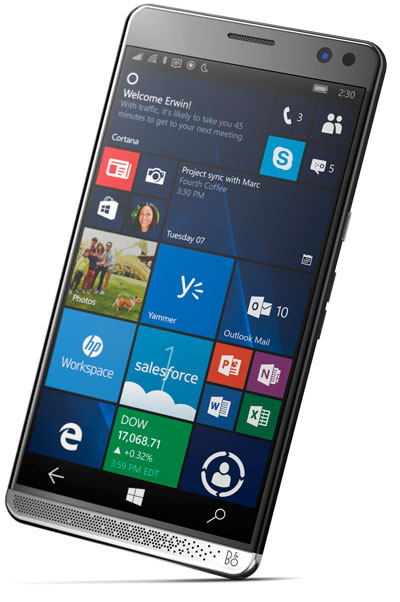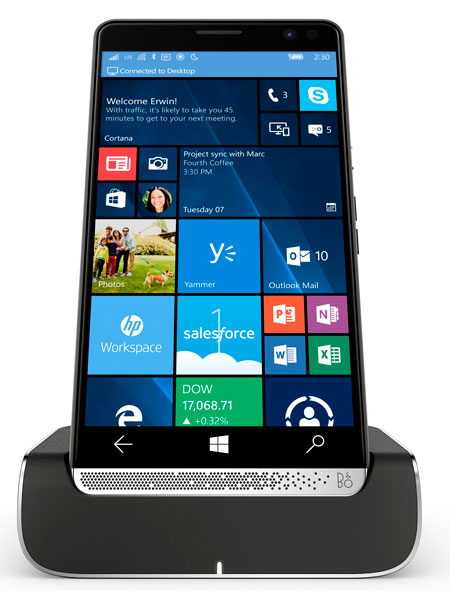In-Depth
HP Makes Another Run at a Windows Phone
HP's three-in-one Elite x3 Windows phone targets the enterprise and the channel.
- By Paul Ferrill
- March 01, 2017
While building out infrastructure and solutions to support mobile workers is a key opportunity for the partner community, few are called upon to include Windows-based phones in the mix, given that just about all smartphones are either Android or iOS-based. The small handful of customers who do want Windows-based phones have few options these days -- either Microsoft's Lumia phones or the recently released HP Elite x3.
HP's new Elite x3, a three-in-one phone, is a worthy option designed to draw the best of what Windows 10 offers. The key element in the release of this product lies in the target audience -- enterprise users. Despite consumer preference for Android phones and Apple iPhones, HP sees a clear opening for a cadre of enterprises looking to fill the void left by the demise of the BlackBerry platform in the hearts and minds of IT managers, and it's all about control.
 Befitting its enterprise focus, the HP Elite x3 builds in management and security technologies.
Befitting its enterprise focus, the HP Elite x3 builds in management and security technologies.
Features key to IT administrators include the ability to secure both physical access to a device and to the stored information. The HP Elite x3 utilizes Microsoft's BitLocker technology to secure the information with 128-bit encryption. It also supports 256-bit full-disk encryption plus secure boot. Manageability is another important IT feature, and the HP Elite x3 fits in well with Microsoft's Enterprise Mobility + Security (EMS) suite of products. Other mobile device management (MDM) products like VMware's AirWatch support the HP Elite x3, as well.
Among the first partners to start working with the new HP Elite x3 was eMazzanti Technologies. "Customers are begging for options to leverage the Microsoft stack in increasingly mobile ways," says Carl Mazzanti, CEO of the Hoboken, N.J., solution provider, which is among Redmond Channel Partner's 200 top U.S. Microsoft partners identified last year. The x3 Elite suits those who "want the power of a desktop in their hands," Mazzanti says.
Desktop, Lapdock and Phone
The Elite x3 attempts to cover all the bases you typically work from with the same device. When you're in the office, there's the desktop dock that provides connections for a monitor, keyboard, mouse and wired Ethernet. When you're away from the office, there's the lapdock for typing on a full-sized keyboard and 12.5-inch display. The lapdock connects to the phone wirelessly or using a USB Type-C cable. When using the USB Type-C connector you also get to take advantage of the 48 WHr battery in the lapdock to charge the phone. The lapdock includes a total of three USB Type-C connectors plus a micro-HDMI port to mirror the screen to an external display.
The phone has a number of unique features, including support for dual SIM cards. In this scenario you could have both a personal and a business number on the same phone. Network support is limited to GSM carriers like AT&T or T-Mobile in the United States. For security, the HP Elite x3 includes both a fingerprint reader and iris recognition. Full support for Windows Hello to simplify secure access takes advantage of the fingerprint and iris capability. Windows Information Protection provides full encryption for enterprise data and makes it possible to seamlessly separate personal and corporate information.
One somewhat hidden feature I discovered while testing the lapdock and phone combination is the ability to use the phone's microphone and voice recognition to dictate into a document. With Word open on the lapdock, it's possible to press the microphone icon on the phone and start talking. While this might not be a highlighted feature, I found it to be quite useful from a cramped airline seat to capture a stream of thought for later editing.
HP Workspace Delivers the Apps
One of the biggest complaints about the Windows Phone platform has been the lack of apps. With the targeted enterprise user, HP has focused on delivering applications using a turnkey application virtualization service. HP Workspace is a cloud-based service with a long list of common applications available on demand. The HP Workspace Service Desk provides custom support to virtualize corporate applications for use through this same service.
HP Workspace works only when the Elite x3 is docked either to the lapdock or the desktop. It really only makes sense to run normal apps on a screen capable of displaying the full experience. One thing you don't get with HP Workspace is cloud-based storage, although there is integration with Box, Dropbox, Google Drive and Microsoft's OneDrive. You do get full-featured applications with HP Workspace to include Microsoft Word, Excel and Outlook. At present, HP doesn't support external key fobs for sending and receiving signed or encrypted e-mail.
 To address the limitations of the Windows Phone app ecosystem, HP offers a turnkey application virtualization service called HP Workspace.
To address the limitations of the Windows Phone app ecosystem, HP offers a turnkey application virtualization service called HP Workspace.
Everyday Phone
It's relatively common these days to see business travelers with two phones, one for business and one that's personal. The big question for the Elite x3 is: Can it be the only phone you need for the common tasks you do with a smartphone? I evaluated the existing available applications with an eye toward the things a typical business traveler would need. While most of those applications for airlines, hotels, rental car agencies and the like are available, in some cases they just don't match up to the same apps on either Android or iOS. This isn't necessarily a dig on the phone but on the Windows Phone platform.
One case in point is the Delta Airlines app. Both the Android and iOS app will display your boarding pass so you don't need to print one out. That's not the case with the Windows Phone version of the Delta app. You can still get the QR code for boarding using a Web page link, but that still isn't quite as simple as the app on other platforms. I did find most of the apps that are typically used while traveling, including Avis, Hilton, Marriott and others. Some of these apps work only on the phone itself so you won't be able to access them on the lapdock or desktop when the phone is docked.
Battery life on the HP Elite x3 is superior to most any other phone on the market. A 16MP rear camera coupled with an 8MP front-facing camera support a wide range of applications, including Skype for video conferencing. The 5.96-inch display is crisp and easy to read outdoors in all but the brightest direct sunlight. Specs include a Qualcomm Snapdragon 820 processor, 4GB of LPDDR4 memory and 64GB of internal storage. Additional storage via a micro-SD memory card can be added in lieu of a second SIM.
"The HP x3 is by far the fastest e-mail client I have ever used. As a road warrior needing to bring my files with me and make quotes or answer questions on the fly, the x3 rocks," Mazzanti says.
Bottom Line
From my testing, the HP Elite x3 does the job it was designed to do quite well. We were able to edit documents and manipulate spreadsheets using both the lapdock and desktop. For most business uses, this covers a large percentage of the typical computer usage when you add in e-mail. I found enough little things that would make it somewhat challenging to totally switch from Android or iOS, but for strictly business use, the HP Elite x3 is a winner. One of the biggest wins is the battery, which outlasts the majority of the phones on the market today.
Pricing
For HP Workspace you can expect to pay $49 per month for the Essential edition, which provides up to 40 hours of usage per month. The Premium version will run you $79 per month and doubles the usage amount to 80 hours. HP also offers a secure VPN service that costs $2,995 per year per gateway. Retail price for the phone by itself currently lists for $699. HP offers bundled packages on its Web site should you wish to purchase the phone plus the desktop dock or the lapdock.
About the Author
Paul Ferrill, a Microsoft Cloud and Datacenter Management MVP, has a BS and MS in Electrical Engineering and has been writing in the computer trade press for over 25 years. He's also written three books including the most recent Microsoft Press title "Exam Ref 70-413 Designing and Implementing a Server Infrastructure (MCSE)" which he coauthored with his son.